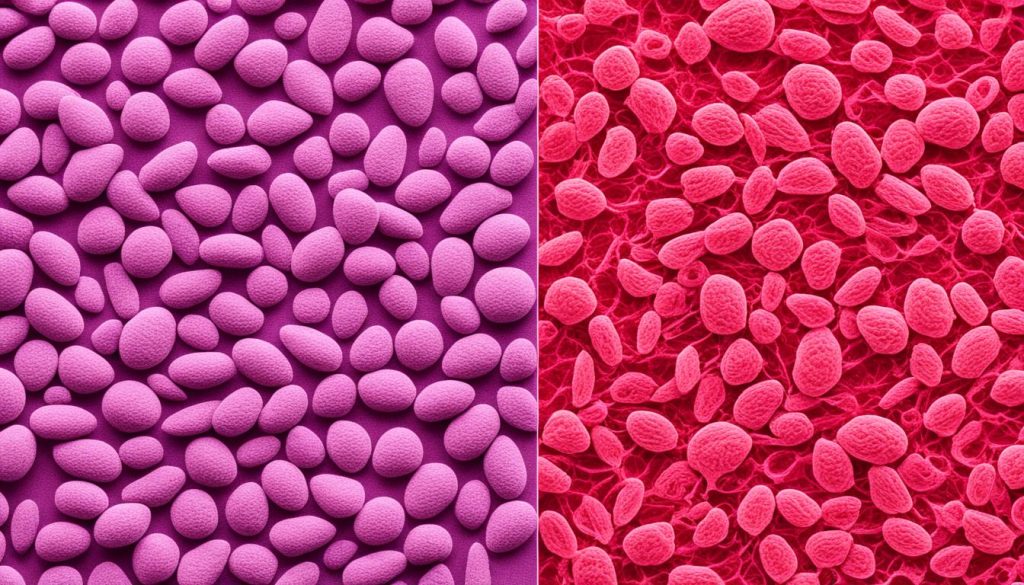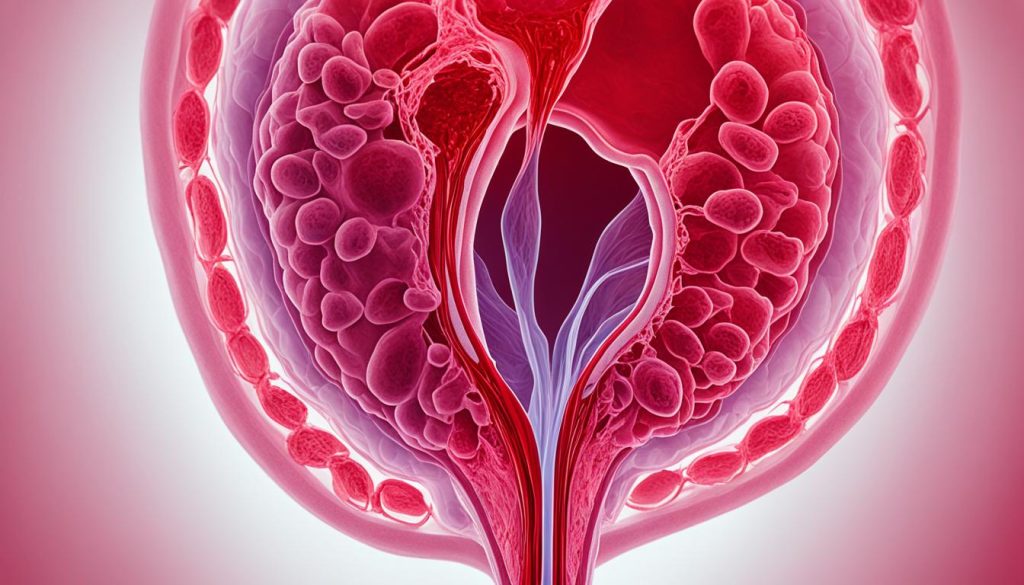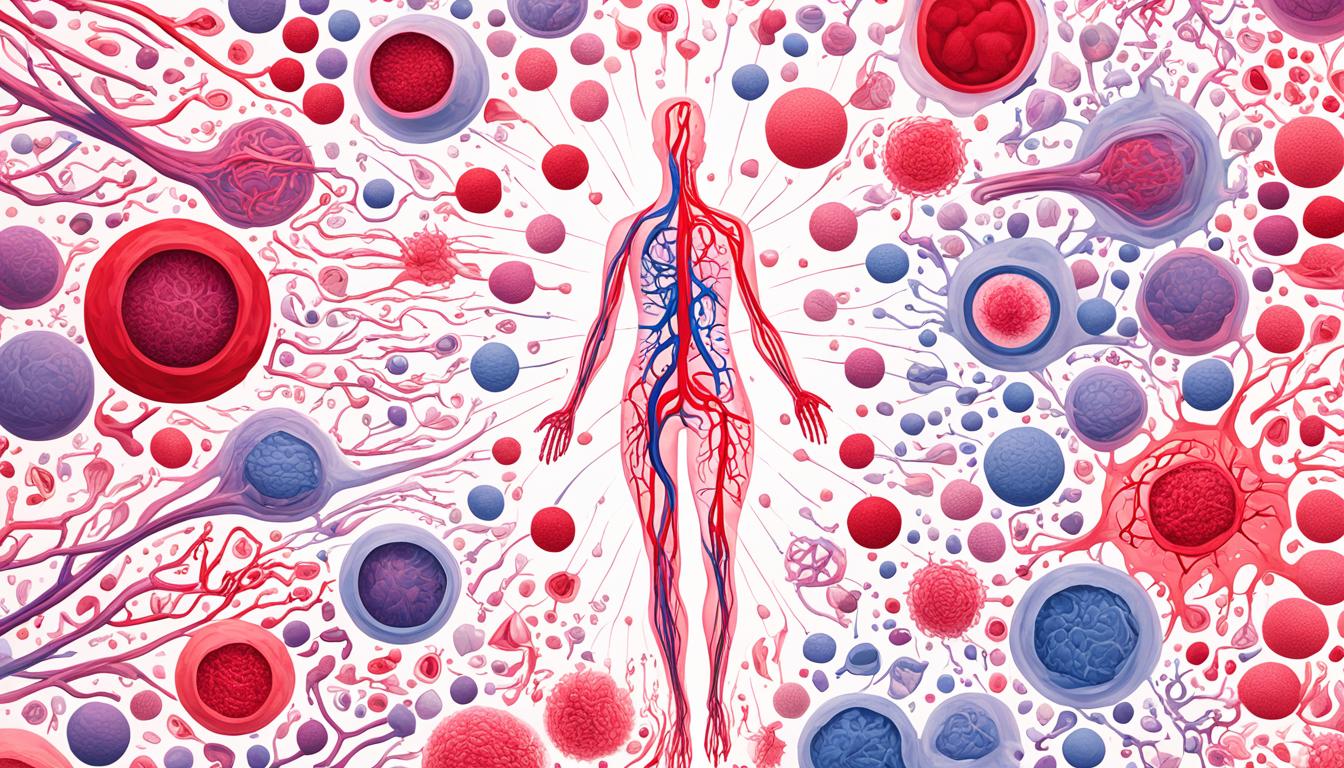Welcome to our informative article on the causes of blood clots during a period. Many women experience menstrual blood clots, and in most cases, they are a normal part of the menstrual cycle. However, certain factors can contribute to the presence of larger blood clots. In this section, we will explore the possible reasons behind heavy periods clotting and menstrual blood clots.
Menstrual clots are a combination of blood cells, tissue from the uterus lining, and proteins in the blood. They play a crucial role in regulating menstrual flow.
However, if menstrual clots are larger than a quarter in size, occur very frequently, or accompany an abnormally heavy flow or severe pain, it is advisable to seek medical advice. In such cases, these clots may be a sign of an underlying medical condition that requires further evaluation and treatment.
In the next sections, we will delve into the characteristics of normal menstrual clots, medical conditions that can cause atypical clotting, potential causes of heavy menstrual flow, when to seek medical attention, and the relationship between heavy menstruation and anemia. We will also discuss diagnosis and treatment options for managing menstrual clotting.
What Causes of Blood Clots During Period?
During menstruation, the body’s defense mechanism triggers the formation of menstrual clots as a natural process. These clots are more likely to occur when the flow is heavy, particularly within the first 2 days of the period.
The characteristics of menstrual clots can vary, including color and size. Clots may range in color from bright red to darker or even black. In terms of size, menstrual clots can be as small as a quarter or larger.
The main function of clotting during menstruation is to prevent excessive blood loss. The clots help coagulate the blood in the uterus, which stops the continued bleeding from the uterine lining. Passing small clots during your period is generally considered normal and not cause for concern.
However, it’s important to note that passing larger clots or experiencing frequent clotting may indicate an underlying health condition that requires medical attention. Identifying the cause behind larger or more frequent clots is crucial for managing menstrual clotting effectively.
Below is an informative table summarizing the characteristics of normal menstrual clots:
| Characteristics | Description |
|---|---|
| Color | Bright red, darker, or black |
| Size | Small (not larger than a quarter) to larger |
| Cause | Natural defense mechanism to prevent excessive blood loss |
| Frequency | More common during heavy flow, especially within the first 2 days of the period |
| Concerns | Passing larger clots or experiencing frequent clotting may indicate an underlying health condition |

Medical Conditions that Cause Atypical Menstrual Clots
Several medical conditions can contribute to the formation of atypical menstrual clots. These include:
- Uterine polyps or fibroids: Non-cancerous growths that can cause heavy flow and clotting.
- Endometriosis: The uterine lining grows outside the uterus, resulting in heavy clots and bleeding.
- Adenomyosis: The uterine lining grows into the muscular wall of the uterus, leading to heavier flow and increased clotting.
- Hormonal imbalances: May affect the coagulation proteins in the uterine lining, causing heavy menstruation or clotting.
- Pregnancy loss: Can contribute to the formation of larger clots.
- Enlarged uterus: May also lead to the formation of larger clots.
- Bleeding disorders: Rare conditions that result in abnormally heavy menstruation.
These medical conditions can disrupt the normal menstrual flow, causing abnormal period clots. It is important to consult a healthcare provider if you experience these symptoms to receive a proper diagnosis and appropriate treatment.
Potential Causes of Heavy Menstrual Flow
Heavy menstrual flow can be a common concern for many women and may contribute to the formation of larger clots during periods. Understanding the potential causes of heavy periods is essential for managing menstrual clotting and minimizing the risk of blood clots during the period.
Uterine Polyps or Fibroids
Uterine polyps and fibroids are non-cancerous growths that can develop in the uterus. These growths can cause heavy periods and clotting, leading to the formation of larger blood clots. Uterine polyps are small, benign tissue growths that can form on the uterine lining, while fibroids are muscular tumors that can vary in size. Both conditions can disrupt the normal menstrual flow and increase the likelihood of clotting.
Hormonal Imbalances
Hormonal imbalances can also contribute to heavy menstrual flow and clotting. Fluctuations in hormone levels, particularly estrogen and progesterone, can affect the thickness of the uterine lining. When the uterine lining becomes excessively thick, it can result in heavy bleeding and the formation of clots. Some hormonal imbalances may be related to conditions such as polycystic ovarian syndrome (PCOS) or thyroid disorders.
Thyroid Conditions
The thyroid gland plays a crucial role in regulating the body’s hormonal balance. Both hypothyroidism (underactive thyroid) and hyperthyroidism (overactive thyroid) can disrupt menstrual cycles and lead to heavy periods with clotting. Thyroid conditions can affect the overall balance of hormones in the body, including those involved in menstruation, and contribute to heavy flow and blood clot risk during the period.
Medications
Certain medications, such as hormonal birth control or anticoagulants (blood thinners), can impact menstrual flow and clotting. Hormonal birth control methods, like the pill or intrauterine devices (IUDs), can alter hormone levels and affect the thickness of the uterine lining, potentially leading to heavier periods and clot formation. Anticoagulant medications, on the other hand, can increase the risk of excessive bleeding and clotting during menstruation.
Chronic Conditions
Chronic conditions like endometriosis and polycystic ovarian syndrome (PCOS) are also associated with heavy periods and clotting. Endometriosis is a condition in which the uterine lining grows outside the uterus, resulting in heavy bleeding and clot formation. PCOS is a hormonal disorder that can cause irregular menstrual cycles, including heavy bleeding and clotting.
If you experience heavy menstrual flow, it is recommended to consult a healthcare provider to determine the underlying cause and explore management options. They can provide further guidance on how to manage menstrual clotting and reduce the risk of blood clots during your period.
When to Seek Medical Attention for Menstrual Clots?
While menstrual clots are generally normal, it’s important to be aware of specific circumstances that may warrant medical attention. Understanding the signs and symptoms that indicate a need for evaluation can help ensure your overall health and well-being.
- Clots larger than a quarter in size: In most cases, menstrual clots are small and pass without causing any concern. However, clots that are larger than a quarter in size may indicate a potential underlying issue that requires medical attention.
- Very frequent clotting: While occasional clotting during your period is normal, experiencing frequent clotting may be a cause for concern. If you consistently notice an increase in the frequency of clot formation, it’s recommended to consult with a healthcare provider.
- Abnormally heavy flow requiring frequent pad or tampon changes: Experiencing an excessively heavy flow that necessitates frequent pad or tampon changes may be a sign of an underlying medical condition. If you find yourself having to change your menstrual products more often than usual, it’s important to speak with a healthcare professional.
- Clots associated with significant pain: Menstrual cramps are a common occurrence during menstruation. However, if you experience severe pain in conjunction with the passing of clots, it could be an indication of an underlying condition that requires medical attention.
If you notice any of these signs during your menstrual cycle, it’s advisable to consult a healthcare provider for further evaluation and treatment. Remember, it’s always better to seek medical advice to ensure your peace of mind and address any potential concerns.

Anemia and Heavy Menstruation
Heavy menstrual bleeding, including clotting, can increase the risk of iron-deficiency anemia. Anemia occurs when there are lower than usual levels of red blood cells in the body. This can happen due to excessive blood loss during heavy periods.
Symptoms of anemia may include general fatigue, weakness, and shortness of breath. Women with heavy menstrual flow and clotting should monitor their iron levels and consider supplements if necessary.

The Impact of Anemia
Anemia can significantly affect daily life, leading to feelings of exhaustion and making it difficult to perform regular activities. It is essential to address anemia to maintain overall well-being and quality of life.
Monitoring Iron Levels
Regular monitoring of iron levels through blood tests can help determine if supplementation is necessary. Iron-rich foods such as lean meats, leafy green vegetables, and fortified cereals can also help boost iron levels naturally.
Iron Supplements
In cases where dietary changes are not sufficient to address low iron levels, healthcare providers may recommend iron supplements. These supplements should be taken as prescribed and under medical supervision to ensure proper absorption and minimize side effects.
Consulting a Healthcare Provider
If heavy menstrual bleeding and clotting persist, it is important to consult a healthcare provider. They can provide further guidance, evaluate underlying causes, and recommend appropriate treatment options to manage heavy periods and minimize the risk of health complications.
| Signs of Anemia | Iron-Rich Foods |
|---|---|
|
|
Diagnosis and Treatment Options for Menstrual Clots
To determine the cause of atypical menstrual clots, healthcare providers use a combination of diagnostic techniques. They may inquire about your symptoms, order blood or imaging tests, and perform a physical examination. These steps are crucial in identifying the underlying cause of your clotting issues and guiding appropriate treatment options.
Diagnostic procedures for menstrual clotting may include:
- Blood tests: By analyzing your blood, healthcare providers can assess your hormone levels, check for clotting disorders, and identify any abnormalities that may contribute to excessive clotting during your menstrual cycle.
- Imaging tests: Ultrasounds or other imaging techniques may be used to visualize your reproductive organs and detect any physical abnormalities, such as fibroids or polyps, that may be responsible for the clotting.
- Physical examination: A pelvic examination allows healthcare providers to assess the condition of your reproductive organs firsthand, helping them identify any visible signs of abnormalities or underlying disorders.
The choice of treatment for managing menstrual clotting depends on the underlying cause and the severity of your symptoms. The goal of treatment is to regulate your menstrual cycle, control bleeding, and alleviate associated pain. Here are some common treatment options:
- Hormonal medications: These medications, such as hormonal birth control pills, can help balance hormone levels and regulate your menstrual cycle. They can be effective in reducing excessive clotting and heavy bleeding.
- Nonsteroidal anti-inflammatory drugs (NSAIDs): These over-the-counter medications can help reduce pain and inflammation associated with menstrual clotting. They are particularly helpful in managing symptoms such as abdominal cramps and heavy bleeding.
- Surgical interventions: In cases where fibroids, polyps, or other physical abnormalities are causing excessive clotting and heavy bleeding, surgical procedures may be recommended. These procedures can remove or treat the underlying cause, providing long-term relief.
- Lifestyle modifications: Certain lifestyle changes can also help manage menstrual clotting. Eating a healthy diet, maintaining a healthy weight, and engaging in regular physical activity can contribute to a balanced menstrual cycle and reduce clotting.

Remember, it’s important to consult with your healthcare provider to determine the most suitable treatment options for your specific situation. They will consider your medical history, symptoms, and underlying conditions to develop an individualized treatment plan that addresses your needs and helps manage menstrual clotting effectively.
Conclusion
While blood clots during a period are generally normal, it is important to pay attention to certain circumstances that may warrant medical attention. Clots larger than a quarter in size, very frequent clotting, an abnormally heavy flow, or clots associated with significant pain should be evaluated by a healthcare provider.
A variety of medical conditions can contribute to the formation of larger or more frequent clots. These include uterine polyps or fibroids, endometriosis, adenomyosis, hormonal imbalances, pregnancy loss, and bleeding disorders. Identifying the underlying cause is crucial in determining the appropriate treatment options.
Treatment for abnormal menstrual clots may include hormonal medications to balance hormones and control bleeding, nonsteroidal anti-inflammatory drugs (NSAIDs) to reduce symptoms and excessive bleeding, and surgical interventions for conditions such as fibroids or polyps. Early detection and proper management can help alleviate symptoms and improve overall well-being.




